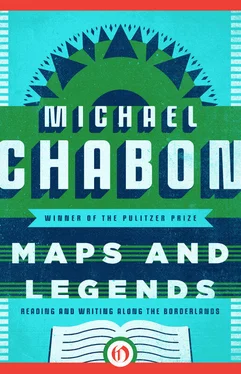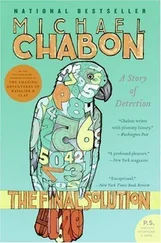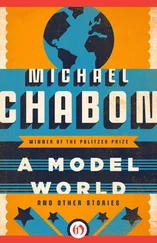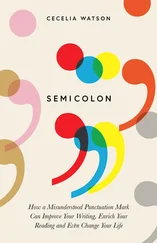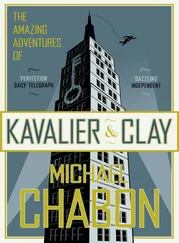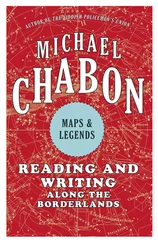That was the second important thing that happened to me when I wrote that story. It was as if I had opened a door and stepped into the room in which all my favorite writers were sitting around waiting for me to show up. They were a disparate bunch, from Judy Blume to Edgar Allan Poe, spread over different eras, continents, and genres. Some were close kin to each other — Lord Dunsany, H. P. Lovecraft — while others seemed to have nothing in common beyond their connection to me. And somehow, I sensed, their intersection defined me. They were, in other words, my family. I derived from them, they explained me. And more than anything else I wanted — I knew it now — to be accounted one of them. This was the wish — to be a credit to that far-flung family of literary heroes — that I have sought to embody, to express in the infinitely malleable clay of language, ever since.
It was around this time, as I was making up my mind to be a writer, that I encountered my second golem. By this time we were living in the then-new town of Columbia, a planned community in the Maryland suburbs, between Baltimore and Washington, D.C. In the waning years of my parents’ marriage — it ended, draw your own conclusions, the year that I began to formulate my wish — one of the only reliable sources of pleasure for my father and me was the weekly trip we took, alone, to the Howard County Public Library’s main branch, then located on Frederick Road, outside of the city limits of Columbia itself. One evening as I was rather sullenly spinning the wire rack of paperbacks intended for a group of readers who were then just becoming known, in the librarian trade, as YAs, I came across a book called Strangely Enough! written by one C. B. Colby and published by Scholastic Book Services. It was one of those mysterious books that you have loved as a child but which as you go out into the world no one else ever seems to have read or even heard of, although the library’s copy was tattered and well worn and had been checked out, to judge from the number of fading purplish dates stamped onto its tan pocket, by dozens of YAs before me. It was made up of a series of about a hundred short pieces, little essays, each about five hundred words long and devoted to exposing or musing over all kinds of inexplicable and supposedly factual incidents and phenomena: poltergeists, haunted paintings, UFO sightings, rains of frogs and stones, witch scares, phantom hitchhikers, encounters with the devil in which he left his cloven footprint clearly visible in a neighborhood rock. I read a few of the entries — enough to persuade me that it was going to turn out to be one of the best books I had ever read — and then carried it with a few other titles to wait for my father at the circulation desk.
“Strangely Enough!” the librarian intoned, putting a little Twilight Zone wobble into her voice. I nodded. “You know he lives here. C. B. Colby.”
It turned out that C. B. Colby lived not merely in Columbia but right down the street from my family, in the small cubistic house stained dark blue, with the goldfish pond, that you had to pass whenever you went to our street’s communal mailbox. His real name was Joseph Adler, and in time I discovered that in addition to Strangely Enough! he was the author of some 250 other works, fiction and nonfiction, for children and YAs, under a bewildering variety of pseudonyms. All I had known of him before now was that he was a baby chick of a man, with a soft, wavering plume of white hair and a gentle if somewhat stiff manner toward children. A reticent, courtly ghost of him, the first real writer I ever knew, can be glimpsed in the figment of a writer called August Van Zorn, in my novel Wonder Boys. Mrs. Adler had died not long after we moved into the neighborhood, and my mother had made him a roast and carried it down to him. The widower, she told me when she returned from this charitable visit, was a “survivor.” I hadn’t heard the term before, though I had an aunt by marriage who had been interned at Auschwitz as a child, and I knew enough, the next time I saw Mr. Adler, to look for and discover the greenish-black numbers on the inside of his forearm.
I was not a bold child. It took me most of the four-week circulation period to get up the nerve to go to his front door, clutching the library’s copy of his book, which by now I had read at least half a dozen times, terrifying myself, ruining my sleep, making the flat, sunny, avocado-and-goldenrod-colored 1973 world of Columbia, Maryland into a strange and marvelous world that contained treasures and ghosts and mysterious bright objects in the sky. Before approaching his house directly, however, I had spent several days furtively lurking nearby, concealing myself behind a bush or the neighbor’s parked car, studying the bare windows behind which nothing ever seemed to move. I saw a piano. I saw a work of iron sculpture that looked something like a mace and something like a gate and something like a twist of barbed wire. I saw thousand and thousands of books. And once I caught a glimpse of Mr. Adler, drinking orange juice straight from the carton.
“Ah,” he said, when he opened the door to me. “My little shadow.”
It would be nice to tell you a story now about how Mr. Adler, the taciturn, intellectual, widowed author of two hundred popular pseudonymous novels, and Michael Chabon, the awkward, unhappy, budding boy-writer skulking around the margins of his neighborhood, his future, and his parents’ divorce, forged an unlikely friendship while teaching each other valuable lessons about literature and life. But it didn’t work out that way; I guess that’s why stories are so much better than life, or rather why stories make life so much better. Mr. Adler invited me in, dismissed Strangely Enough! with a contemptuous wave of his hand, poured me a glass of orange juice that I felt a little bit nervous about drinking, and told me that my eyeglasses were much too big for my face. The house was filled with all kinds of spiky and unnerving sculptures, some all welded steel, like the one I’d seen from the window, others done in wood, plaster, and glass. They were the work, he explained to me, of his wife. Just before I departed his house for the first and last time, he took me into his office and pointed to the neatly stacked pages of a manuscript sitting beside his great steely battleship of an IBM Selectric. “That is the first book I will ever put my own name upon,” he said. There was a faint trace of an accent; it made me think of my aunt Renee, who had been in the camps too. “What kind of book is it?” I asked him. He looked annoyed. “It’s a memoir, of course,” he said. “The story of my life.”
It was as he was walking me, almost herding me, really, toward the door, that I noticed, lying on the glass shelf of a chrome-plated étagère, what I took to be another example of his late wife’s work. It was a clay doll, about the size of the old G.I. Joes they used to have — big enough to whip Ken’s vinyl ass. This clay figure was lumpy and crooked and almost looked as if it had been made by a kid, and I remember considering whether I ought and then deciding not to ask Mr. Adler if he had any children. You could tell, somehow, that he did not. It was a just a glimpse that I got, that day, of the little clay man. Then I was out the door.
I imagine there may be some of you who remember the name “Joseph Adler.” You may have read his memoir, The Book of Hell, which I still see from time to time in used bookstores, its black jacket tattered or missing. My father-in-law owns a copy, though he has an extensive library of books on Jewish subjects and owns copies of a lot of books that nobody reads anymore. I have a copy of my own, one which my father bought right after it came out. It’s a well-written, fairly brutal account of the two years the author, a Prague-born Jewish journalist, spent in Theresienstadt. All the usual horrors are present, and although there is an interesting chapter on the secret camp newspaper, Vadem, in the end there is nothing really to distinguish the book from any of the many literary memoirs that have been written about those times. The only passage of interest to us here is a brief paragraph that concerns, very much in passing, the Golem of Prague:
Читать дальше
Конец ознакомительного отрывка
Купить книгу
